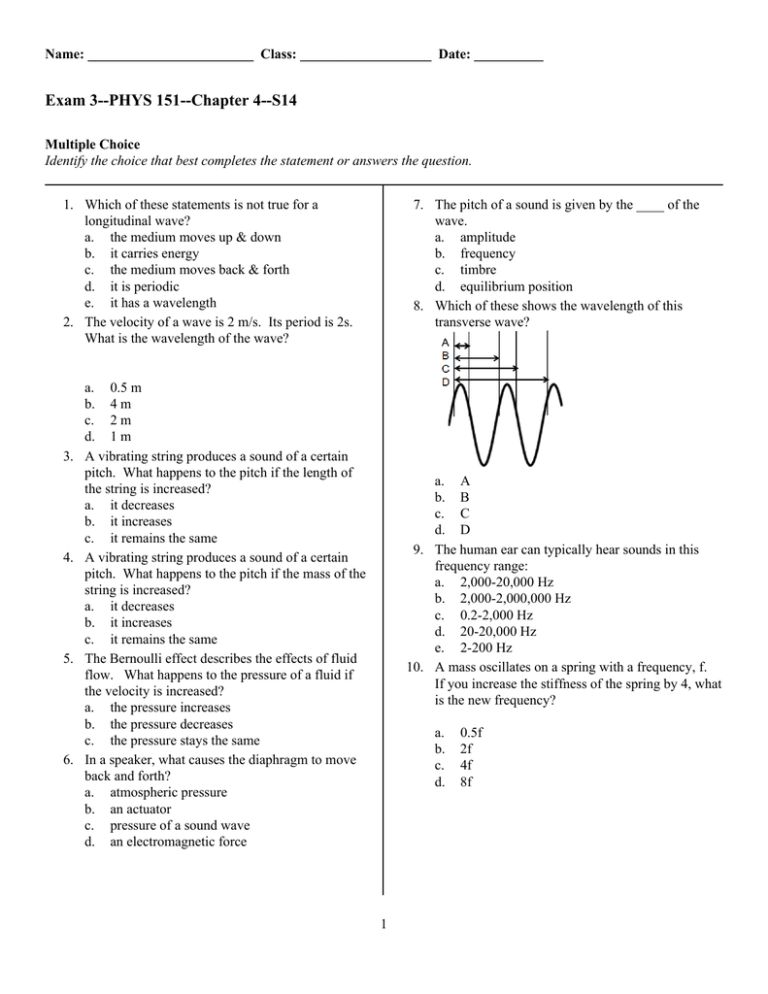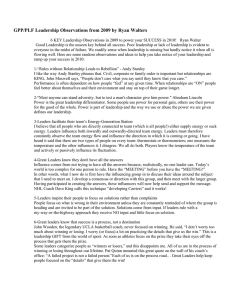Exam 3--PHYS 151--Chapter 4--S14
advertisement

ame: ________________________ Class: ___________________ Date: __________ Exam 3--PHYS 151--Chapter 4--S14 Multiple Choice Identify the choice that best completes the statement or answers the question. 1. Which of these statements is not true for a longitudinal wave? a. the medium moves up & down b. it carries energy c. the medium moves back & forth d. it is periodic e. it has a wavelength 2. The velocity of a wave is 2 m/s. Its period is 2s. What is the wavelength of the wave? 3. 4. 5. 6. 7. The pitch of a sound is given by the ____ of the wave. a. amplitude b. frequency c. timbre d. equilibrium position 8. Which of these shows the wavelength of this transverse wave? a. 0.5 m b. 4 m c. 2 m d. 1 m A vibrating string produces a sound of a certain pitch. What happens to the pitch if the length of the string is increased? a. it decreases b. it increases c. it remains the same A vibrating string produces a sound of a certain pitch. What happens to the pitch if the mass of the string is increased? a. it decreases b. it increases c. it remains the same The Bernoulli effect describes the effects of fluid flow. What happens to the pressure of a fluid if the velocity is increased? a. the pressure increases b. the pressure decreases c. the pressure stays the same In a speaker, what causes the diaphragm to move back and forth? a. atmospheric pressure b. an actuator c. pressure of a sound wave d. an electromagnetic force a. A b. B c. C d. D 9. The human ear can typically hear sounds in this frequency range: a. 2,000-20,000 Hz b. 2,000-2,000,000 Hz c. 0.2-2,000 Hz d. 20-20,000 Hz e. 2-200 Hz 10. A mass oscillates on a spring with a frequency, f. If you increase the stiffness of the spring by 4, what is the new frequency? a. b. c. d. 1 0.5f 2f 4f 8f ame: ________________________ 18. The “Wave” at a football game is what type of wave? a. electromagnetic wave b. transverse wave c. longitudinal wave d. compressional wave 19. During a time of one period, a wave travels ___. a. with a frequency of 1 Hz b. one wavelength c. one amplitude d. it depends on the period 20. The glottal stop is ______. a. relaxing of the vocal cords b. a closing of the glottis c. a technique to increase the loudness of your voice d. folding of the vocal folds 21. You stand two meters from a point source of sound, and the intensity is I. If you move 4 meters away, what is the new intensity? a. ¼I b. I c. 4I d. ½I e. 2I 22. The loudness of a sound is most closely affected by the ____. a. period b. amplitude c. frequency d. wavelength 23. Ultrasound equipment could operate at which of these frequencies? a. 5,000 Hz b. 10,000,000 Hz c. 0.1 Hz d. 20 Hz 24. Intensity is defined as which of these: a. Power*Area b. Power/Area c. Area/Power d. Power 11. You increase a sound’s intensity level by 20 dB. By how much has the intensity changed? a. 100 W/m2 b. 0.1 W/m2 c. 20 W/m2 d. 10 W/m2 e. 0.01 W/m2 12. Cochlear implants ____. a. Change the wavelength of the sound b. Send an electrical signal to the brain c. Change the frequency of the sound d. Amplify sound 13. The spring constant, k, describes the ___ of a spring a. mass b. stiffness c. frequency d. wavelength 14. Hearing aids primarily ____. a. Change the frequency of the sound b. Send an electrical signal to the brain c. Change the wavelength of the sound d. Amplify sound 15. Which of these may result in hearing loss? I. Buildup of earwax II. Middle ear infection III. Loss of hair cells IV. Perforation of eardrum a. I & II b. I, II, & III c. III & IV d. All of these 16. The larynx provides which primary purpose(s)? I. Protect the vocal cords II. Move the vocal cords III. Generate sound IV. Amplify sound a. I & II b. I only c. I, II, & IV d. II and III 17. On a piano, the highest pitched notes come from the ___ strings. a. longest b. shortest 2 ame: ________________________ 25. Consider this diagram for the next 5 questions: 26. 27. 28. 29. 30. What is the intensity level of the quietest sound you can hear? a. 1 dB b. -1 dB c. 10-12 dB d. 0 dB 31. Ultrasound technology is similar to _____. a. diffraction b. amplification c. echolocation d. interference 32. Consider this figure. What best describes the part labeled (1)? Which of these is called the auditory canal? a. (2) b. (4) c. (5) d. (6) e. (7) From the above diagram, which part is called the auricle? a. (1) b. (2) c. (3) d. (5) e. (7) From the above diagram, which part is used to equalize the pressure between the middle ear and atmosphere? a. (2) b. (3) c. (4) d. (5) e. (7) From the above diagram, which part contains hair cells? a. (3) b. (4) c. (5) d. (6) e. (7) From the above diagram, which part carries an electrical signal to the brain? a. (3) b. (4) c. (5) d. (6) e. (7) a. thyroid b. vocal cords c. larynx d. trachea e. glottis 33. Consider the previous figure. What is the part labeled (2)? a. trachea b. glottis c. thyroid d. vocal cords e. larynx 34. Which of these is most elastic? a. liquid b. gas c. plasma d. solid 35. A sonic boom occurs when the speed of the vehicle exceeds the ____. a. wave period b. wave frequency c. wavelength d. wave speed 3 ame: ________________________ 40. Ultrasound waves travel about 1500 m/s in the human body. A ultrasound imaging device operates at 3,000,000 Hz. What is the size of the smallest feature distinguishable by the imager? 36. Sound travels fastest in which of these a. gas b. solid c. plasma d. liquid 37. In a gas, which of these would increase the speed of sound in that gas? I. Increase the temperature of the gas II. Increase the density of the gas III. Increase the mass of the gas particles a. II only b. I, II, & III c. I only d. I & II 38. Consider these 3 waves. Which has the larger frequency? 41. 42. 43. a. A b. B c. C d. all the same 39. Consider the 3 waves in the previous problem. Which has the longer wavelength? a. A b. B c. C d. all the same 44. 45. 4 a. 0.000002 m b. 0.045 m c. 0.0005 m d. 0.5 m What is the function of the ossicles? a. to resonate with particular frequencies of sound b. to convert vibrations to an electrical signal c. transfer vibrations from the eardrum d. to vibrate the vocal cords 50 db is ____ times as intense as 30 db. a. 1500 b. 0.6 c. 100 d. 20 e. 1.7 Vibration of the vocal cords is caused by which of these phenomena? a. Bernoulli effect b. Pascal’s principle c. Resonance d. Boyle’s Law Noise-canceling headphones operate because of _______. a. selecting out particular frequencies b. amplification of sound c. radio waves d. the interference of sound waves The pitch of an individual’s voice is modulated by changing _________. a. the length of the vocal cords b. the mass of the vocal cords c. the tension of the vocal cords d. the size of the glottis ame: ________________________ 46. Men’s voices are lower-pitched, primarily, because they ____. a. have longer vocal cords b. have more testosterone c. have more massive vocal cords d. are taller 47. The speed of a wave is dependent on its ____. a. frequency b. wavelength c. medium d. all of these e. none of these 48. Air is forced past the vocal cords because of work done by the ___. a. glottis b. diaphragm c. lungs d. larynx 49. What is a condensation? a. a secretion in the middle ear b. a portion of a sound wave where the medium is compressed c. the closing of the glottis d. rain drops falling on your head 50. You are using Version A of this exam. Bubble “A” for this problem. a. A b. B c. C d. D Problem 51. Some equations: f = 2π k m f= 1 2L T µ 5 ID: A Exam 3--PHYS 151--Chapter 4--S14 Answer Section MULTIPLE CHOICE 1. 2. 3. 4. 5. 6. 7. 8. 9. 10. 11. 12. 13. 14. 15. 16. 17. 18. 19. 20. 21. 22. 23. 24. 25. 26. 27. 28. 29. 30. 31. 32. 33. 34. 35. 36. 37. 38. 39. ANS: ANS: ANS: ANS: ANS: ANS: ANS: ANS: ANS: ANS: ANS: ANS: ANS: ANS: ANS: ANS: ANS: ANS: ANS: ANS: ANS: ANS: ANS: ANS: ANS: ANS: ANS: ANS: ANS: ANS: ANS: ANS: ANS: ANS: ANS: ANS: ANS: ANS: ANS: A B A A B D B B D B A B B D D A B B B B A B B B A A D D E D C C A D D B D A C PTS: PTS: PTS: PTS: PTS: PTS: PTS: PTS: PTS: PTS: PTS: PTS: PTS: PTS: PTS: PTS: PTS: PTS: PTS: PTS: PTS: PTS: PTS: PTS: PTS: PTS: PTS: PTS: PTS: PTS: PTS: PTS: PTS: PTS: PTS: PTS: PTS: PTS: PTS: 1 1 1 1 1 1 1 1 1 1 1 1 1 1 1 1 1 1 1 1 1 1 1 1 1 1 1 1 1 1 1 1 1 1 1 1 1 1 1 1 ID: A 40. 41. 42. 43. 44. 45. 46. 47. 48. 49. 50. ANS: ANS: ANS: ANS: ANS: ANS: ANS: ANS: ANS: ANS: ANS: C C C A D C A C B B A PTS: PTS: PTS: PTS: PTS: PTS: PTS: PTS: PTS: PTS: PTS: 1 1 1 1 1 1 1 1 1 1 1 PROBLEM 51. ANS: . PTS: 1 2



